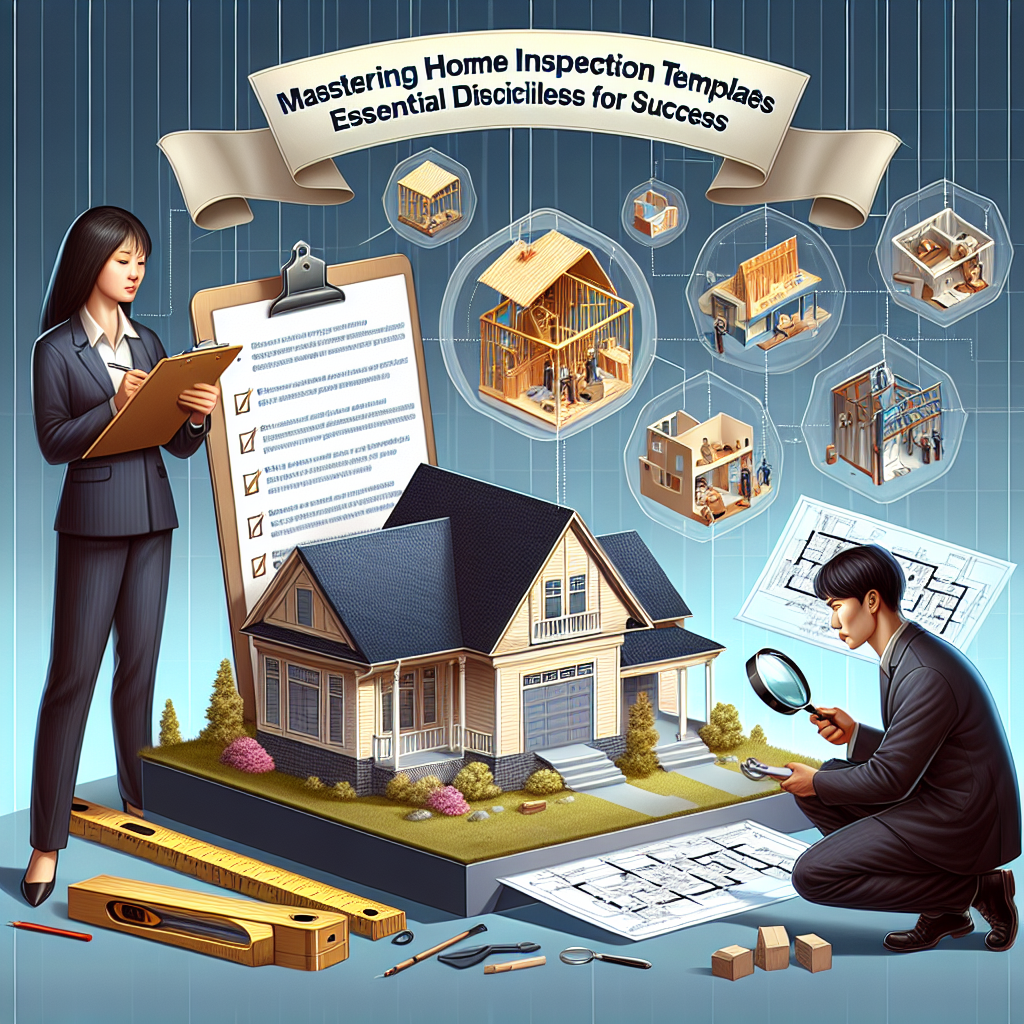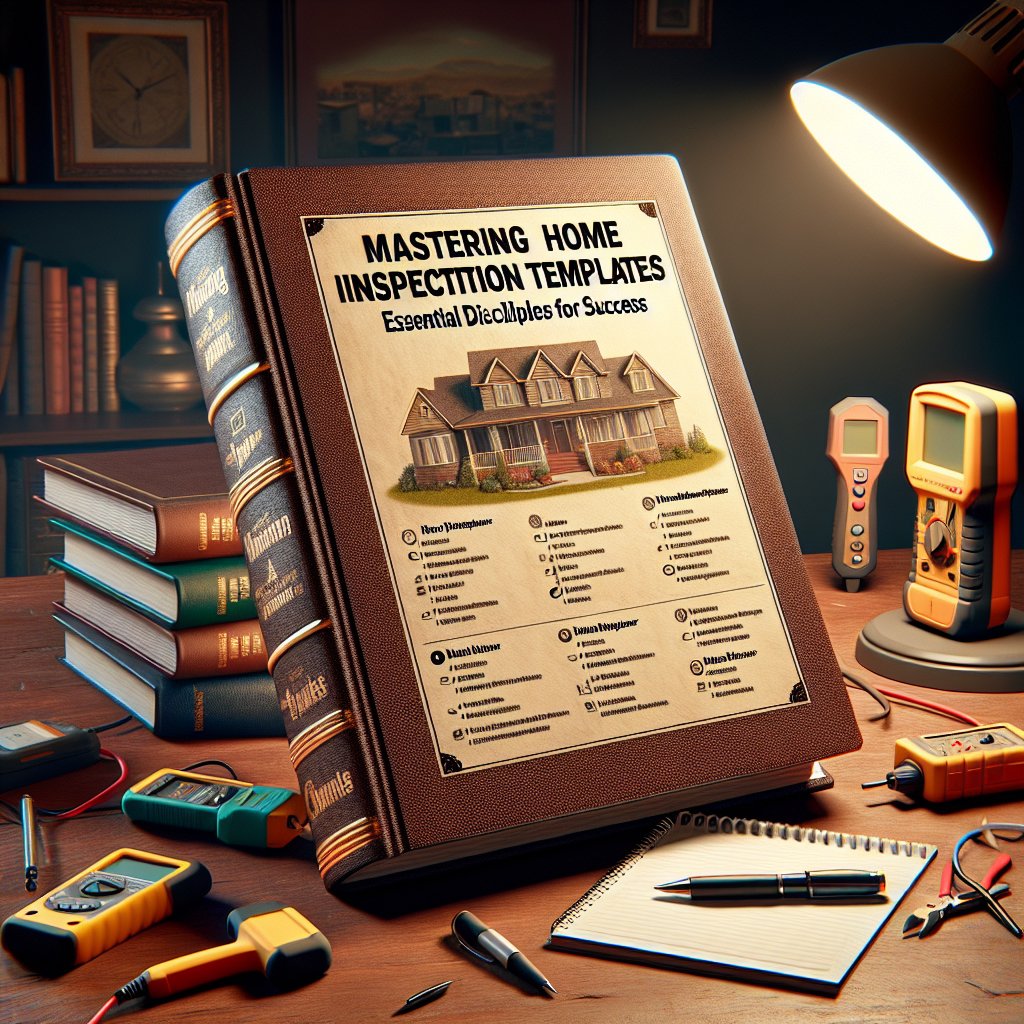Mastering Home Inspection Templates: Essential Disciplines for Success is a comprehensive guide that provides valuable insights and strategies for professionals in the field of home inspection. This resource offers essential disciplines and best practices necessary to develop effective home inspection templates, enabling inspectors to conduct thorough and efficient evaluations of residential properties. By following the guidelines outlined in this article, readers can enhance their knowledge, streamline their processes, and ultimately achieve success in their home inspection careers.

The Importance of Standardized Home Inspection Templates
Home inspection is a critical process in the real estate industry, ensuring that properties meet certain standards before they are bought or sold. To carry out an effective and efficient home inspection, professionals rely on standardized templates that guide them through the evaluation process. These templates play a crucial role in maintaining consistency and ensuring thoroughness during inspections. This article explores the importance of using standardized home inspection templates and provides insights into how professionals can master their utilization.

Standardized home inspection templates offer numerous benefits to both inspectors and clients. Firstly, these templates provide a structured approach to conducting inspections, ensuring that no aspect is overlooked. By following a predefined checklist of items to evaluate, inspectors can systematically assess each area of a property, including structural elements, electrical systems, plumbing fixtures, heating and cooling systems, among others.
Furthermore, standardized templates foster consistency among different inspectors working within the same organization or across various companies. Regardless of individual experience levels or personal preferences regarding inspection techniques or priorities when evaluating specific aspects of properties, these templates ensure that all inspections adhere to a uniform set of standards. This not only guarantees fairness but also enhances the credibility of professional organizations offering home inspection services.
In addition to promoting consistency in assessments conducted by multiple inspectors over time or within an organization itself, standardized templates also enable easier comparisons between different properties. By using consistent criteria for evaluations across various homes or buildings being inspected under similar conditions (e.g., pre-purchase evaluations), it becomes simpler for buyers to compare potential purchases objectively based on objective information provided by independent inspectors who utilize identical evaluation tools.
To truly master the use of home inspection templates effectively requires discipline in several key areas. Firstly , it is important for professionals to regularly update their knowledge about industry regulations and best practices related to property inspections as this ensures they stay up-to-date with any changes in legal requirements governing what must be included within standard template forms used during inspections. By staying current on these matters, inspectors can ensure that their evaluations remain accurate and comprehensive.
Secondly, professionals must exercise discipline when adapting standardized templates to fit the unique characteristics of each property being inspected. While templates provide a solid framework for conducting inspections, they should not be regarded as rigid documents set in stone. Inspectors need to exercise judgment and adapt the template as necessary to suit specific circumstances or client requirements while still adhering to industry standards.
Furthermore, mastering home inspection templates requires ongoing practice and refinement of inspection techniques. Professionals should strive to improve their efficiency in completing evaluations without compromising the quality or thoroughness of their work. This might involve developing effective strategies for organizing inspection activities efficiently or utilizing technology tools such as mobile applications that facilitate data collection and report generation.
In conclusion, standardized home inspection templates are vital tools for ensuring consistency and objectivity within the real estate industry. These templates enable inspectors to assess properties systematically while providing clients with reliable information regarding potential purchases. To master the use of these templates effectively, professionals must maintain an up-to-date knowledge base, adapt them appropriately according to individual property characteristics, and refine their inspection techniques through regular practice and incorporation of new technologies. By doing so, inspectors can enhance their credibility while delivering high-quality services that meet the needs of both clients and regulatory authorities alike.
Key Elements to Include in Your Home Inspection Template
Home inspections play a vital role in the real estate industry. They provide potential buyers with valuable information about the condition of a property, helping them make informed decisions before making one of the biggest investments of their lives. However, conducting thorough home inspections can be a challenging task without an organized and comprehensive template to guide you through the process. In this article, we will discuss some key elements that should be included in your home inspection template.
Firstly, it is essential to include general property information at the beginning of your template. This includes details such as the address, owner’s name, contact information, and date of inspection. Having these details readily available ensures that you have accurate records for future reference and easy communication with all parties involved.

Next, consider incorporating sections for documenting exterior observations. This part typically covers elements like roofing materials, gutters and downspouts conditions, siding quality and integrity, windows and doors conditions – including any signs of damage or wear-and-tear. Remember to take note of any safety hazards or potential structural issues that might require further investigation.
Moving on to interior observations – these are crucial components to consider during a home inspection. Create sections dedicated to assessing walls and ceilings conditions (looking out for cracks or water damage), flooring types found throughout various rooms (paying close attention to warped floorboards or uneven surfaces), electrical systems (including outlets placements) & lighting fixtures assessment , plumbing system checks – ensuring there are no leaks from faucets or pipes – HVAC systems functioning properly etc…
In addition to visual assessments, including spaces within your template where inspectors can note any smells they detect is also beneficial when inspecting homes because unpleasant odors could indicate underlying problems such as mold growth or pest infestations.
The basement is often considered an important area warranting special attention due its susceptibility towards dampness and other potential issues. Hence, create sections in your template to document the condition of basement walls, floors, and any signs of water intrusion or damage. Additionally, check for proper insulation and ventilation systems.
Including a section to assess the attic is also necessary. Look for signs of leaks or moisture damage on the ceiling and walls. Check if there are adequate levels of insulation installed as this can greatly affect energy efficiency.
Finally, it is crucial to include a comprehensive checklist in your home inspection template covering all areas that need assessment during an inspection. This checklist ensures that you do not miss anything important while conducting the inspection and provides consistency across different properties.
Transitional phrases such as “moving on,” “in addition,” and “finally” help guide readers smoothly through each idea presented in this article. By including these key elements in your home inspection template – from general property information to detailed interior observations – you can ensure that no stone is left unturned during the inspection process. Having a well-structured template helps maintain consistency and professionalism throughout each evaluation conducted by inspectors within the real estate industry.
Best Practices for Customizing Home Inspection Templates
Home inspection is a crucial process that ensures the safety and quality of a residential property. To effectively conduct a home inspection, inspectors rely on templates to streamline their work and ensure consistency in reporting. These templates serve as a framework for recording observations, documenting findings, and generating detailed reports.
Customizing home inspection templates to fit specific needs is an essential discipline that every inspector should master. By tailoring these templates to reflect individual preferences and requirements, inspectors can enhance their efficiency and accuracy in performing inspections. In this article, we will explore best practices for customizing home inspection templates.
The first step in customizing a template is understanding its purpose and components. A well-designed template typically consists of sections related to various aspects of the house, such as exterior features, interior spaces, electrical systems, plumbing systems, heating and cooling systems, structural elements, among others. Each section contains fields or checkboxes where inspectors can enter information or select predefined options based on their findings during the inspection.
Inspectors should carefully review each section of the template and consider whether any additional sections or fields are necessary for capturing specific details relevant to their local area or industry standards. For example, if they frequently inspect properties located near bodies of water prone to flooding risks, it may be beneficial to add a section dedicated to assessing flood-related vulnerabilities.
Furthermore,enriching existing fields with more comprehensive descriptions can improve clarity in reporting findings.For instance,rather than simply stating “cracks observed,” inspectors might provide additional context by specifying crack width,direction,and location.Ambiguity must be minimized since accurate representation allows homeowners,buyers,and other stakeholders make informed decisions about repairs or improvements required.
Consistency across all sections of the template is crucial.To ensure uniformity,it’s advisable to use consistent language ,tone ,and terminology throughout the document .Maintaining clear communication will prevent misunderstandings between different parties involved,such as contractors or insurance companies.
Another essential aspect of template customization is incorporating relevant codes and regulations. Inspectors should consult local building codes, safety standards, and industry guidelines to ensure that their templates accurately reflect the legal requirements for residential properties in their area. By including specific code references within the template, inspectors provide a transparent and professional approach to reporting compliance or deficiencies.
To optimize efficiency during inspections, customizing templates should also include leveraging digital technology. Utilizing mobile applications or software programs specifically designed for home inspection can significantly enhance productivity and accuracy.Capturing photos,drawing diagrams,and using voice-to-text features enable faster data entry while reducing the risk of errors.In addition,a digital format allows easy integration with other tools,such as report-generating software,resulting in streamlined workflows.
Lastly,it is vital to periodically review and update customized templates based on evolving industry trends or personal experiences.Gaining feedback from fellow inspectors or engaging in professional development activities provides valuable insights into potential areas for improvement.Staying abreast of emerging technologies,policies,and best practices helps inspectors adapt their templates accordingly to maintain high-quality work.
In conclusion,mastering the art of customizing home inspection templates is an essential discipline that every inspector must embrace.Customization involves understanding each component of the template,tailoring it according to individual needs,integrating relevant codes,and leveraging digital technology.Furthermore,regular updates ensure that these templates remain effective tools for enhancing efficiency and providing accurate assessments.With dedication and continuous improvement,inspectors will be well-equipped to navigate any home inspection challenge successfully
Streamlining the Reporting Process with Efficient Templates

Home inspection is a critical aspect of the real estate industry, as it ensures that properties are safe and structurally sound. To achieve accurate and efficient home inspections, inspectors must have a systematic approach to gathering information and documenting their findings. This is where home inspection templates come into play. By utilizing well-designed templates, inspectors can streamline the reporting process and enhance overall efficiency.
One essential discipline for successful template usage is customization. Each property being inspected has its unique features and requirements; therefore, using generic templates will not suffice. Inspectors must invest time in customizing their templates to match specific aspects of each property they inspect. This may include sections for electrical systems, plumbing fixtures, or structural elements that require special attention based on previous observations or local regulations.
Moreover, ensuring consistency throughout the report is crucial for professionalism and clarity. A well-structured template allows inspectors to follow a standardized format when documenting their findings across different properties. Consistency aids in readability and comprehension both by other professionals within the field who may need to review the report or potential buyers seeking an overview of a property’s condition.
Another vital discipline lies in including clear descriptions alongside visual evidence within the template design. Often, photographs are taken during inspections to provide visual proof of any issues discovered during assessment; however, without accompanying explanations, these images may be misleading or confusing to readers unfamiliar with technical jargon or construction terminology. Descriptive captions should be integrated into templates to ensure that every photograph adds value by explicitly highlighting pertinent details related to identified concerns.
Furthermore, optimizing data collection through electronic forms simplifies record keeping and data management while reducing errors associated with manual inputting processes such as handwriting interpretation mistakes or lost paper reports. Leveraging technology enables inspectors to utilize pre-built digital forms on mobile devices or laptops instead of cumbersome paper-based approaches.
To maximize efficiency even further, templates can be designed to include checkboxes or dropdown menus for standardized responses. These features minimize the time spent on data entry and allow inspectors to focus their attention on inspecting properties rather than writing extensive narratives about each aspect examined. By offering predefined options, templates not only enhance accuracy but also speed up the report generation process.
In addition to improving efficiency in documenting findings, inspection templates can also serve as educational tools for new inspectors or those unfamiliar with certain property aspects. When structured thoughtfully, templates prompt inspectors to systematically assess various areas of a property that they might otherwise overlook due to inexperience or lack of knowledge.
Lastly, continuous improvement is essential when utilizing home inspection templates. Regularly reviewing and updating these forms based on feedback from experienced colleagues or any changes in industry standards ensures that the reporting process remains up-to-date and aligned with best practices. Templates should never be regarded as static documents but rather dynamic tools that evolve alongside advancements within the field.
In conclusion, mastering home inspection templates is crucial for streamlining the reporting process and achieving success as a home inspector. Customization, consistency, clear descriptions with visual evidence integration, electronic form utilization for optimized data collection, standardized responses through checkboxes or dropdown menus, educative prompts within templates themselves, and continuous improvement are all disciplines necessary to unlock the potential of these efficient tools. Embracing these principles will enable inspectors to generate accurate reports efficiently while maintaining professionalism and adhering to industry standards consistently
How to Effectively Use Technology in Home Inspection Templates
Technology has revolutionized many industries, and the home inspection field is no exception. In today’s digital age, inspectors can take advantage of powerful tools to streamline their processes and improve their efficiency. One such tool is the use of home inspection templates.
Home inspection templates are pre-designed forms that inspectors can use to document their findings during a property assessment. These templates come in various formats, including spreadsheets, online forms, or specialized software applications. By utilizing these templates effectively, home inspectors can ensure consistency and accuracy in their reports while saving time and effort.

One essential discipline for success in using technology-driven home inspection templates is thorough preparation. Before conducting an inspection, it is crucial for inspectors to familiarize themselves with the template they will be using. This involves understanding how each section of the template corresponds to different aspects of a property evaluation and determining which areas require specific attention.
By preparing ahead of time, inspectors can ensure that they cover all necessary elements during an inspection and avoid overlooking critical details that could impact a report’s quality or completeness. Furthermore, being well-versed in the template allows inspectors to work more efficiently as they navigate through various sections without confusion or delays.
Another crucial aspect when utilizing technology-driven home inspection templates is effective data collection. With traditional pen-and-paper methods becoming obsolete in most industries, it’s important for inspectors to embrace digital tools for capturing data during inspections accurately.
Inspectors should leverage features such as checkboxes or drop-down menus within their chosen template to input information swiftly and precisely. Additionally, using mobile devices like tablets or smartphones enables them to easily snap photos or record videos as visual evidence alongside written descriptions within the template itself.
By embracing these technological advancements for data collection purposes, not only do inspectors save significant amounts of time but also reduce human error associated with manual transcription tasks later on—a win-win situation when aiming for optimal efficiency and accuracy within the industry.
Efficient organization is yet another vital discipline required when working with home inspection templates. Templates often come with sections and subsections that need to be completed in a logical order, mirroring the flow of an inspection itself. Inspectors must ensure they navigate through each part systematically, avoiding any redundancies or omissions.
To facilitate this process, inspectors can use transitional phrases like “next,” “subsequently,” or “following on from” when moving from one section to another within their template. This not only helps maintain coherence and structure within the report but also allows readers—whether clients or fellow professionals—to follow along effortlessly.
Lastly, it is crucial for inspectors to embrace continuous improvement as a discipline when using technology-driven home inspection templates. As technology evolves rapidly, so do the available tools and software applications designed specifically for inspections.
Inspectors should remain open-minded and keep up-to-date with emerging technologies relevant to their profession. By attending conferences or workshops dedicated to home inspections and networking with other professionals in the field, inspectors can stay informed about the latest advancements in template design and functionality.
In conclusion, effective utilization of technology-driven home inspection templates requires several essential disciplines. These include thorough preparation before conducting an assessment, efficient data collection during inspections utilizing digital tools, maintaining organized reports by navigating through templates systematically using transitional phrases for guidance, and embracing continuous improvement by staying informed about new technological developments in the industry.
By mastering these disciplines, inspectors can elevate their efficiency levels while ensuring accuracy and consistency across all aspects of their work—ultimately leading them towards success in today’s technologically advanced world of home inspections.
Tips for Ensuring Accuracy and Consistency in Template Usage
Using home inspection templates can greatly streamline the inspection process, ensuring that no important details are overlooked. However, to maximize the benefits of these templates, it is essential to use them with accuracy and consistency. In this article, we will discuss some key tips to help you master home inspection templates and achieve success in your inspections.
Firstly, it is crucial to carefully review each template before conducting an inspection. Take the time to familiarize yourself with its layout, sections, and fields. Understanding how the template is structured will make it easier for you to fill in the necessary information accurately. Make note of any specific instructions or guidelines provided within the template as well.
Secondly, when using a template, ensure that all relevant areas are covered during your inspection. Templates typically include standard sections such as exterior components, interior features, electrical systems, plumbing systems, and more. However, every property is unique and may have additional elements that require attention. Tailor your template accordingly by adding or modifying sections as needed.
Moreover, t’s vital to be meticulous when completing each field within a home inspection template. Being attentive to detail ensures accuracy in recording observations, determining conditions, and noting any defects. Ensure clear communication by using descriptive language while filling out these fields. For instance, rather than simply stating ‘damaged roof,’ specify ‘shingles missing on south-facing side of roof.’ This level of specificity allows for better understanding among parties involved, such as homeowners ,buyers,and real estate agents.
Furthermore,in order maintain consistency across inspections,a standardized approach should be followed.Utilize consistent terminology throughout your report.For example,’deficient’ instead of ‘poor condition’ or ‘improper installation’.This avoids confusion and ambiguity.Referencing industry standards,codes,and regulations can also add credibility.Consistency extends beyond individual reports;it applies across all inspections conducted by an organization.This means that multiple inspectors should be using the same templates and adhering to established procedures.
In addition,consider incorporating digital tools into your template usage.Digital platforms allow for easier data entry and storage,as well as quick retrieval of past inspection reports.Use a tablet or smartphone to input information directly into the template,reducing the chance of errors associated with manual transcriptions. Utilize features such as dropdown menus,rating scales,and photo uploads to enhance accuracy,efficiency,and visual representation within your report.Opting for a cloud-based system enables easy collaboration among team members and instant access to reports from anywhere at any time.
Another tip for ensuring accuracy is performing thorough quality control checks before submitting your final report.Go through each section meticulously.Verify that all fields have been filled out correctly,Cross-check against your notes,take additional photographs if necessary, and ensure that there are no inconsistencies in the information provided.Avoid relying solely on automated spell checkers;manually proofread your report for grammatical errors.This level of attention ensures that your report is error-free,polished,and professional.
Lastly,continual improvement is essential in mastering home inspection templates. As you gain experience and encounter different scenarios,don’t hesitate to refine or update your templates.Understand what works best for you and make adjustments accordingly.Seek feedback from clients or colleagues who may provide valuable insights.Consider attending workshops or training sessions related to home inspection reporting techniques.Adopting new technologies,exploring emerging industry trends,and staying updated with regulations can help elevate the quality of inspections over time.
To conclude,mastering home inspection templates requires careful attention to detail,a standardized approach,careful utilization of digital tools ,thorough quality control checks,and a commitment towards continual improvement.By following these tips,you can ensure accuracy consistency,maximize efficiency during inspections while providing high-quality reports that meet client expectations
Overcoming Common Challenges when Implementing Home Inspection Templates
Implementing home inspection templates can be a daunting task for many professionals in the industry. It requires careful planning, attention to detail, and an understanding of the common challenges that may arise during this process. In this article, we will explore some of these challenges and provide practical solutions to help you overcome them.
One common challenge faced by professionals when implementing home inspection templates is resistance from team members. Some individuals may resist using templates because they feel it restricts their creativity or adds unnecessary complexity to their workflow. To address this challenge, it is crucial to communicate the benefits of using templates clearly. Explain how standardized inspections can improve efficiency, reduce errors, and ensure consistency across all inspections performed by your team.

Another challenge that often arises when implementing home inspection templates is the need for customization. Every property is unique and may require specific items to be inspected or additional notes included in the report. To overcome this challenge, consider creating a template with sections that can easily be customized or modified based on individual property requirements. This way, inspectors can tailor each inspection while still benefiting from a standardized framework.
Technical difficulties are another common hurdle faced during the implementation of home inspection templates. This could include issues such as software compatibility problems or difficulty in integrating new technology into existing workflows. To address these challenges, invest time in researching and selecting software tools that are user-friendly and compatible with your current systems. Provide thorough training sessions for your team members to ensure they understand how to use these tools effectively.
Furthermore, lack of awareness about available resources can hinder successful implementation of home inspection templates. Many professionals may not be aware of online platforms or industry associations that offer pre-made template options suitable for their needs. By actively seeking out resources and sharing them with your team members, you can save time on developing templates from scratch while also ensuring access to well-designed formats tailored specifically for home inspections.
Resistance from clients is yet another challenge faced when implementing home inspection templates. Some clients may prefer a more personalized approach or have concerns about the level of detail provided in a template-generated report. To address this, consider offering customizable sections within your template that allow for additional information to be included based on client preferences. This way, you can strike a balance between providing standardized reports and meeting individual client needs.
Lastly, it is essential to regularly review and update your home inspection templates to keep them relevant and effective. As technology advances and industry standards evolve, so too should your templates. Encourage feedback from your team members and clients regarding areas for improvement or any new requirements that may arise over time.
In conclusion, implementing home inspection templates requires careful consideration of the challenges that may arise during this process. By addressing resistance from team members, customizing templates as needed, resolving technical difficulties, seeking out available resources, managing client expectations, and maintaining regular updates to the templates themselves – professionals in the industry can overcome these challenges successfully. With a well-designed template system in place, you can improve efficiency while ensuring consistency across all inspections performed by your team – ultimately leading to greater success in the field of home inspections. In conclusion, mastering home inspection templates is crucial for success in the field of home inspection. These templates provide a structured approach to conducting inspections and ensure that all important aspects are thoroughly examined. By consistently using these templates, inspectors can improve their efficiency, accuracy, and professionalism. They also help in organizing and documenting findings, which is essential for providing comprehensive reports to clients. Therefore, by understanding and implementing the essential disciplines involved in using home inspection templates effectively, inspectors can enhance their performance and establish themselves as trusted professionals in the industry.
